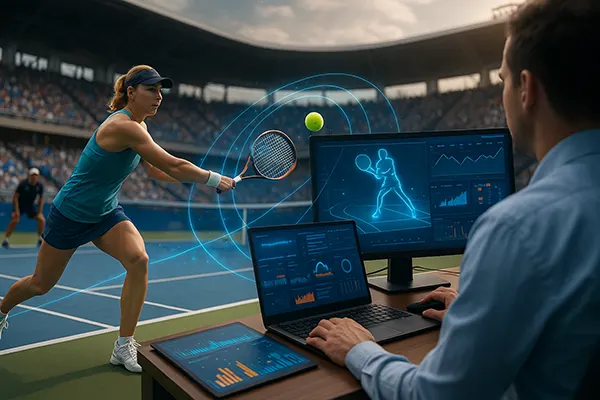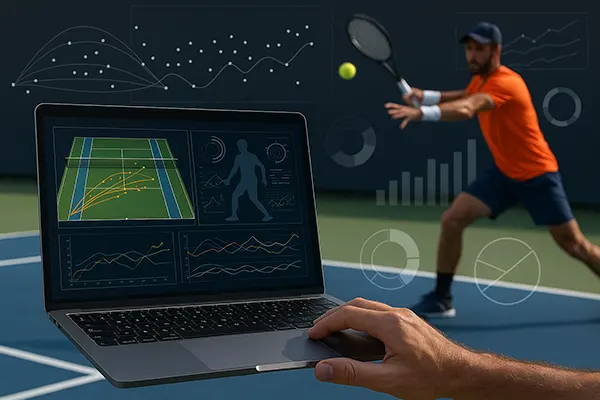Data analytics has become one of the most influential drivers of progress in professional tennis. Over the last decade, the sport has adopted advanced tracking technologies, artificial intelligence models and predictive systems that help players refine their performance and coaches understand competitive patterns at a deeper level. By 2025, analytical tools are shaping strategic decisions, real-time match adjustments and long-term training programmes with unprecedented precision.
The evolution of data-driven performance analysis in tennis
The shift towards analytical thinking in tennis began with the adoption of ball-tracking systems that accurately captured shot trajectories and player movement. As these systems became more sophisticated, they enabled coaches to uncover patterns that previously went unnoticed. Today, athletes rely on comprehensive datasets to monitor consistency, aggression levels, court positioning and pressure-related decision-making across different match stages.
Modern analytical tools aggregate thousands of data points from every rally, helping specialists measure the effectiveness of tactical choices. For example, analysts can quantify how often a player wins points when attacking the net, or how their serve placement changes when facing break points. By comparing these metrics with historical data, experts can identify areas where specific improvements will provide measurable advantage.
The use of wearable devices further enhances this data-driven approach. These devices record physiological indicators such as heart rate, acceleration and workload intensity throughout matches and training sessions. The combination of physical, tactical and biomechanical data gives coaching teams a holistic view of performance and recovery needs.
How AI-assisted systems improve training efficiency
Artificial intelligence algorithms are now capable of analysing match footage with remarkable accuracy. These systems break down rallies into structured components, tag shot types automatically and classify strategic behaviours. This enables coaches to review matches more efficiently than when relying on manual tagging, ensuring every relevant aspect of gameplay is evaluated systematically.
AI-powered training tools simulate realistic match scenarios, helping players rehearse specific tactical responses. For instance, virtual opponents can replicate the playing style of competitors based on historical performance data. This allows athletes to prepare for upcoming matches with personalised training sessions that accurately reflect their opponents’ tendencies.
Machine learning models also support injury prevention by detecting patterns that indicate fatigue, strain or biomechanical imbalance. By recognising subtle indicators early, support teams can adjust training loads to reduce injury risks and maintain consistent competitive readiness throughout the season.
Predictive forecasting and its impact on professional strategy
Match outcome forecasting has advanced significantly due to improvements in data availability and computing power. Modern predictive models assess serve quality, break-point conversion, baseline stability, movement efficiency and mental resilience indicators to estimate how a match may unfold. Although these forecasts are not absolute, they offer valuable strategic insights.
Analysts use forecasting to identify tactical vulnerabilities before a match begins. For example, if a model indicates that an opponent struggles to defend wide serves on key points, coaching teams can incorporate this into match planning. Similarly, long-term forecasts help players understand how different surface types influence their performance metrics across the season.
Performance projections also play an important role in scheduling decisions. By evaluating expected workload and recovery demands, teams can choose optimal tournament combinations that maximise performance potential without overloading the athlete physically or mentally.
The role of real-time analytics during competition
Real-time data processing allows coaching teams to adjust tactics while a match is in progress. Although on-court coaching rules vary by tournament, off-court analysis remains crucial. Live dashboards display serve patterns, rally lengths, directional tendencies and unforced error distribution, helping teams evaluate which tactics generate the most value in specific situations.
Real-time analytics are particularly important during decisive moments. By highlighting which strategies have previously succeeded under pressure, data systems provide players with practical guidance on shot selection and risk management. This support ensures that crucial decisions are based on evidence rather than intuition alone.
These analytical insights also inform post-match reviews. Coaches can immediately assess how a tactical plan performed, identify inconsistencies and modify future training sessions accordingly. This rapid feedback loop accelerates player development and strengthens competitive resilience.

How data analytics is reshaping the future of tennis coaching
Coaching philosophies have evolved significantly due to the integration of analytical tools. Traditional training methods are now complemented by data-supported frameworks that quantify progress with high accuracy. Coaches use performance dashboards to monitor improvement in specific areas such as serve velocity, rally tolerance and defensive transitions.
These frameworks also encourage more individualised training. Instead of applying uniform drills, coaching teams create personalised programmes based on each athlete’s tactical identity, physical strengths and long-term objectives. This ensures that every session contributes directly to measurable advancement.
The growing availability of data also improves collaboration within support teams. Fitness coaches, analysts, psychologists and physiotherapists work together using unified datasets, ensuring that their strategies align with the athlete’s broader performance goals. This integrated approach enhances communication, reduces training inconsistencies and fosters a more structured high-performance environment.
Future innovations expected by 2030
By 2030, experts anticipate even deeper integration of AI-based tools in professional tennis. Enhanced vision systems will capture micro-movements with millimetre-level precision, enabling biomechanical models that evaluate technique efficiency in unprecedented detail. These improvements will support more precise adjustments to stroke mechanics and footwork.
Predictive models will continue to advance, incorporating contextual factors such as crowd influence, altitude, temperature and psychological resilience indicators. This will allow analysts to generate more refined projections for match outcomes and training recommendations tailored to specific tournaments.
There is also growing interest in developing athlete-controlled data environments. Such systems will allow players to manage their performance information independently, ensuring transparency, security and consistency across different analytic platforms. This shift will empower athletes to make informed decisions about how their data is used and shared within the professional environment.




